
The Berlin Wall was a guarded concrete barrier that encircled West Berlin of the Federal Republic of Germany from 1961 to 1989, separating it from East Berlin and the German Democratic Republic. Construction of the Berlin Wall was commenced by the government of the GDR on 13 August 1961. It included guard towers placed along large concrete walls, accompanied by a wide area that contained anti-vehicle trenches, beds of nails and other defenses. The primary intention for the Wall's construction was to prevent East German citizens from fleeing to the West.

Wedding is a locality in the borough of Mitte, Berlin, Germany. It was a separate borough in the north-western inner city until it was fused with Tiergarten and Mitte in Berlin's 2001 administrative reform. At the same time the eastern half of the former borough of Wedding—on the other side of Reinickendorfer Straße—was separated as the new locality of Gesundbrunnen.

Hans Conrad Schumann, also known as Konrad Schumann, was an East German Bereitschaftspolizei who escaped to West Germany during the construction of the Berlin Wall in 1961.

The Berlin border crossings were border crossings created as a result of the post-World War II division of Germany. Prior to the construction of the Berlin Wall in 1961, travel between the Eastern and Western sectors of Berlin was completely uncontrolled, although restrictions were increasingly introduced by the Soviet and East German authorities at major crossings between the sectors. This free access, especially after the closure of the Inner German border, allowed the Eastern Bloc emigration and defection to occur. East German officials, humiliated by this mass defection, subsequently chose to erect the Berlin Wall in order to prevent residents from leaving East Germany.

Berlin Bornholmer Straße is a railway station in the Prenzlauer Berg district of Berlin, Germany. It is served by the Berlin S-Bahn and the M13 and 50 lines of the Berlin Straßenbahn.

Günter Litfin was a German tailor who became the second known person to die at the Berlin Wall. Litfin was the first victim to be killed by East German border troops, the first to succumb to gunshot wounds, and was the first male victim.

Mitte is a central section of Berlin, Germany, in the eponymous borough of Mitte. Until 2001, it was itself an autonomous district.

Gesundbrunnen is a locality (Ortsteil) of Berlin in the borough (Bezirk) of Mitte. It was created as a separate entity by the 2001 administrative reform, formerly the eastern half of the former Wedding district and locality. Gesundbrunnen has the highest percentage of non-German residents of any Berlin locality, at 35.1% as of the end of 2008.

The Chapel of Reconciliation is a place of worship in Berlin, Germany. It stands on the site of the old Church of Reconciliation, on Bernauer Strasse in the Mitte district.

Ida Siekmann was a German nurse who became the first known person to die at the Berlin Wall, only nine days after the beginning of its construction.
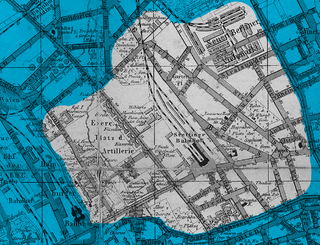
Oranienburger Vorstadt is a historic district of Berlin in what is now the northwestern part of Mitte and the adjacent Gesundbrunnen area, in the modern Mitte borough.
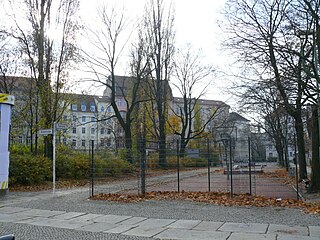
The Ackerstraße is a street in Berlin which runs northwest from near the Liesenstraße – Scheringstraße traffic circle in Gesundbrunnen to Invalidenstraße, where it turns south, terminating at the Linienstraße in Mitte.

The Gedenkstätte Berliner Mauer commemorates the division of Berlin by the Berlin Wall and the deaths that occurred there. The monument was created in 1998 by the Federal Republic of Germany and the Federal State of Berlin. It is located on Bernauer Straße at the corner of Ackerstraße and includes a Chapel of Reconciliation, the Berlin Wall Documentation Centre, a 60-metre (200 ft) section of the former border, a window of remembrance and a visitor center.
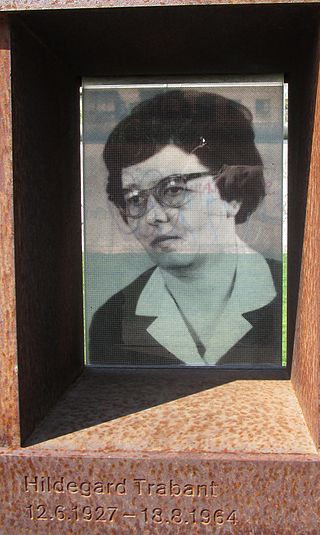
Hildegard Johanna Maria Trabant was an East German woman who became the fiftieth known person to die at the Berlin Wall. Trabant was shot and killed by East German border guards during a crossing attempt, one of only eight women victims of the Berlin Wall, and was the only escapee victim known to have a record of loyalty toward the East German regime.

Egon Schultz was a German sergeant of the East German Border Troops who became the fifty-second known person to die at the Berlin Wall. While responding to the discovery of "Tunnel 57," Schultz was killed during a shootout with the tunnelers. Schultz subsequently became a national hero in East Germany, with hundreds of memorials and schools named in his honor. His death caused a public sensation in both East Germany and West Germany. Following the reunification of Germany and the report that Schultz was actually killed as a result of friendly fire, many of the memorials to Schultz were removed, although a new memorial plaque was erected at his death site at Strelitzer Strasse 55, Berlin, in 2004.
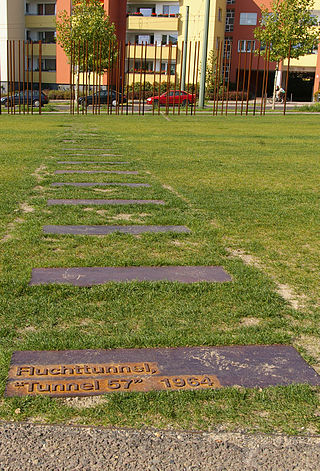
Tunnel 57 was a tunnel under the Berlin Wall that on 3 and 4 October 1964 was the location of a mass escape by 57 East Berlin citizens to West Berlin. It was built from the basement of an empty bakery at 97 Bernauer Straße in West Berlin, under the Berlin Wall – which at that time and place consisted of empty, bricked-up apartment buildings on the east side of Bernauer Straße – all the way to a disused outhouse in the rear courtyard at 55 Strelitzer Straße in East Berlin. At a depth of 12 meters (39 ft) and a length of 145 meters (476 ft), Tunnel 57 was the longest, deepest and most expensive flight tunnel built in Berlin. Thirty-five West Berliners, including Wolfgang Fuchs, the future astronaut Reinhard Furrer, and many students from the Freie University in West Berlin, helped to build the tunnel from April to October 1964, until on 3 and 4 October 57 people fled the GDR via the tunnel.
Klaus Brueske was a German truck driver who became the sixteenth person to die at the Berlin Wall. Brueske died in an attempt to break through the Heinrich-Heine-Straße border crossing in a truck, and was the first Berlin Wall victim to die from suffocation.

Olga Segler was a German woman who died of injuries as a result of crossing the Berlin Wall.
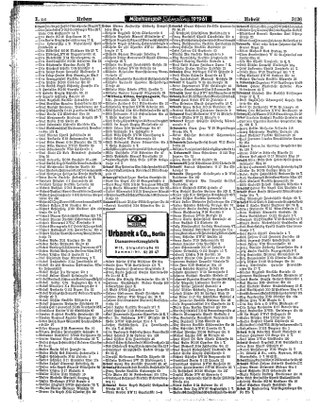
Rudolf Urban was a German man who died as a result of injuries sustained while crossing the Berlin Wall.
![Bernauer Strasse in 1978: Walled up Versohnungskirche (Reconciliation Church Versohnungskirche (Berlin-Mitte) [de]), demolished 1985; replaced by the Kapelle der Versohnung (Chapel of Reconciliation) in 2000 Versohnungskirche Bernauer Strasse.jpg](http://upload.wikimedia.org/wikipedia/commons/thumb/a/a2/Vers%C3%B6hnungskirche_Bernauer_Stra%C3%9Fe.jpg/220px-Vers%C3%B6hnungskirche_Bernauer_Stra%C3%9Fe.jpg)































